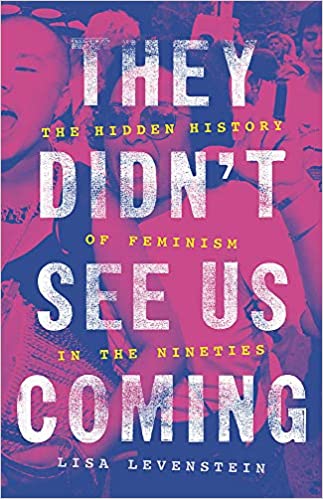The Book
They Didn’t See Us Coming: The Hidden History of Feminism in the Nineties
The Author(s)
Lisa Levenstein

In 1998, the cover story for Time magazine asked if feminism was dead; for many, the answer was yes. The heyday of the women’s liberation movement seemed to be a relic of a bygone era, and corporations watered down female-dominated resistance into marketable “girl power” products (2–5). But Lisa Levenstein argues that there is a lesser-known history of feminism that grew out of the 1990s, and contemporary feminist movements can trace their roots to this particular moment in time when women of different racial and economic backgrounds transformed the way social issues were addressed. Levenstein centers her story on the 1995 United Nations Fourth World Conference on Women that convened in Beijing. Many of the women who attended the conference represented organizations that were not typically associated with feminism, such as groups advocating disability rights or environmental justice (11). In the U.S., the feminist movement tended to be led largely by white, middle-class women, and the version of feminism that arose in the nineties was often portrayed in simplistic terms, usually as a “third wave” of younger, sex positive feminists. This forum, however, demonstrated that international feminism was intergenerational, multicultural, and spanned the economic spectrum (29).
Key to this event’s importance was how U.S. feminists learned about the effects of neoliberalism and U.S. imperialism from women in other countries who faced these realities firsthand. American women knew about manufacturing moving abroad and welfare programs being slashed, but many of them remained ignorant on how intertwined American politics were with the economy of the Global South (33–34). The rise of the worldwide web aided these networking opportunities. In 1995, the online universe was in its early stages: no Google, no social media, no Wi-Fi, no smart phones. Many were just learning how to use email and computers for the first time (46). But thanks to some tech-savvy feminists at the conference, hundreds of women signed up for email mailing lists and began communicating online through text-based discussion boards (52). Levenstein points out that contemporary organizing like the 2017 Women’s March can trace its roots to this period when feminists started taking their activism online. Levenstein notes that the internet “enabled thousands of people—many of whom had been working and thinking in isolation, with no connection to established organizations—to become part of vibrant feminist communities. In chatrooms and on blogs, they created new worlds, interspersing fun and laughter with searing personal revelations and political analysis” (60). With the advent of the internet, women in marginalized communities could now communicate with each other around the globe. Online spaces popped up for all kinds of feminist issues, such as groups specifically for Muslim women, activists fighting for abortion rights, organizations addressing the problem of domestic violence and poverty, and even sites dedicated to creating DIY zines (70–74). African American women, for instance, used the power of the internet to plan the 1997 Million Woman March, with their website getting over a million hits by the time of the actual event (76). These connections prompted some to turn feminism into a career. From starting non-profits to organizing their workplaces, nineties women expanded the goals of feminism into every aspect of their lives (80–84).
Levenstein acknowledges that these budding relationships were not always in agreement about their objectives. Online discussions would often get heated, and many groups ended up competing for limited funding (91). Still, the 1990s proved to be a transformative era for activism, a time when feminism expanded to include more women of color within its ranks and more awareness of global economic and labor issues (130–131). They Didn’t See Us Coming provides first-person accounts of how feminism changed in the nineties from women who were actually there, making it a useful text for anyone interested in the history (and future) of women’s organizing.
About the Reviewer
Shalon van Tine is a Ph.D. candidate in American cultural history at Ohio University and an adjunct professor at University of Maryland Global Campus.

One Thought on this Post
S-USIH Comment Policy
We ask that those who participate in the discussions generated in the Comments section do so with the same decorum as they would in any other academic setting or context. Since the USIH bloggers write under our real names, we would prefer that our commenters also identify themselves by their real name. As our primary goal is to stimulate and engage in fruitful and productive discussion, ad hominem attacks (personal or professional), unnecessary insults, and/or mean-spiritedness have no place in the USIH Blog’s Comments section. Therefore, we reserve the right to remove any comments that contain any of the above and/or are not intended to further the discussion of the topic of the post. We welcome suggestions for corrections to any of our posts. As the official blog of the Society of US Intellectual History, we hope to foster a diverse community of scholars and readers who engage with one another in discussions of US intellectual history, broadly understood.
I had a podcast conversation with Levenstein on this book at New Books in Gender Studies. For who want to listen https://newbooksnetwork.com/search?+q=Levenstein